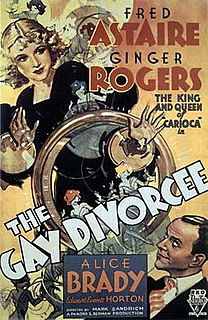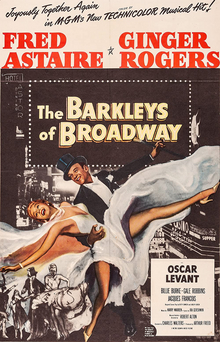
The Gay Divorcee is a 1934 American musical film directed by Mark Sandrich and starring Fred Astaire and Ginger Rogers. It also features Alice Brady, Edward Everett Horton, Eric Blore, and Erik Rhodes. The screenplay was written by George Marion Jr., Dorothy Yost, and Edward Kaufman. Robert Benchley, H. W. Hanemann, and Stanley Rauh made uncredited contributions to the dialogue. It was based on the Broadway musical Gay Divorce, written by Dwight Taylor, which had been adapted into a musical by Kenneth S. Webb and Samuel Hoffenstein from an unproduced play by J. Hartley Manners.

Top Hat is a 1935 American musical screwball comedy film in which Fred Astaire plays an American tap dancer named Jerry Travers, who comes to London to star in a show produced by Horace Hardwick. He meets and attempts to impress Dale Tremont to win her affection. The film also features Eric Blore as Hardwick's valet Bates, Erik Rhodes as Alberto Beddini, a fashion designer and rival for Dale's affections, and Helen Broderick as Hardwick's long-suffering wife Madge.

Ginger Rogers was an American actress, dancer and singer during the Golden Age of Hollywood. She won an Academy Award for Best Actress for her starring role in Kitty Foyle (1940), and performed during the 1930s in RKO's musical films with Fred Astaire. Her career continued on stage, radio and television throughout much of the 20th century.

Fred Astaire was an American dancer, actor, singer, choreographer, and television presenter. He is widely considered the greatest dancer in film history.

Harriet Nelson was an American singer and actress. Nelson is best known for her role on the sitcom The Adventures of Ozzie and Harriet.

Swing Time is a 1936 American musical comedy film, the sixth of ten starring Fred Astaire and Ginger Rogers. Directed by George Stevens for RKO, it features Helen Broderick, Victor Moore, Betty Furness, Eric Blore and Georges Metaxa, with music by Jerome Kern and lyrics by Dorothy Fields. Set mainly in New York City, the film follows a gambler and dancer, "Lucky" (Astaire), who is trying to raise money to secure his marriage when he meets dance instructor Penny (Rogers) and begins dancing with her; the two soon fall in love and are forced to reconcile their feelings.

Flying Down to Rio is a 1933 American pre-Code RKO musical film famous for being the first screen pairing of Fred Astaire and Ginger Rogers, although Dolores del Río and Gene Raymond received top billing and the leading roles. Among the featured players are Franklin Pangborn and Eric Blore. The songs in the film were written by Vincent Youmans (music), Gus Kahn and Edward Eliscu (lyrics), with musical direction and additional music by Max Steiner. During the initial year that a Best Original Song was given during 7th Academy Awards, the film obtained a nomination for MUSIC (Song) – "Carioca," Music by Vincent Youmans; Lyrics by Edward Eliscu and Gus Kahn [came in 3rd]. Ironically, the song lost to "The Continental" from The Gay Divorcee, the subsequent film of Fred Astaire and Ginger Rogers after Flying Down to Rio.

Hermes Pan was an American dancer and choreographer, principally remembered as Fred Astaire's choreographic collaborator on the famous 1930s movie musicals starring Astaire and Ginger Rogers. He worked on nearly two dozen films and TV shows with Astaire. He won both an Oscar and an Emmy for his dance direction.

A Damsel in Distress is a 1937 English-themed Hollywood musical comedy film starring Fred Astaire, George Burns, Gracie Allen and Joan Fontaine. Loosely based upon the P.G. Wodehouse 1919 novel of the same name, and the 1928 stage play written by Wodehouse and Ian Hay, it has music and lyrics by George and Ira Gershwin, and was directed by George Stevens, the second Astaire musical directed by Stevens; the first was Swing Time.

The Barkleys of Broadway is a 1949 Technicolor musical film from the Arthur Freed unit at Metro-Goldwyn-Mayer that reunited Fred Astaire and Ginger Rogers after ten years apart. Directed by Charles Walters, the screenplay is by Betty Comden, Adolph Green and Sidney Sheldon, the songs are by Harry Warren (music) and Ira Gershwin (lyrics) with the addition of "They Can't Take That Away from Me" by George and Ira Gershwin, and the choreography was created by Robert Alton and Hermes Pan. Also featured in the cast were Oscar Levant, Billie Burke, Jacques François and Gale Robbins. It is the last film that Astaire and Rogers made together, and their only film together in color. Rogers came in as a last minute replacement for Judy Garland, whose frequent absences due to a dependence on prescription medication cost her the role.

This is a comprehensive guide to over one hundred and fifty of Fred Astaire's solo and partnered dances compiled from his thirty-one Hollywood musical comedy films produced between 1933 and 1968, his four television specials and his television appearances on The Hollywood Palace and Bob Hope Presents the Chrysler Theatre which cover the period from 1958 to 1968. Further information on the dance routines may be obtained, where available, by clicking on the film links.

Carefree is a 1938 musical film starring Fred Astaire and Ginger Rogers. With a plot similar to screwball comedies of the period, Carefree is the shortest of the Astaire-Rogers films, featuring only four musical numbers. Carefree is often remembered as the film in which Astaire and Rogers shared a long on-screen kiss at the conclusion of their dance to "I Used to Be Color Blind," all previous kisses having been either quick pecks or simply implied.

Shall We Dance, released in 1937, is the seventh of the ten Fred Astaire-Ginger Rogers musical comedy films. The story follows an American ballet dancer (Astaire) who falls in love with a tap dancer (Rogers); the tabloid press concocts a story of their marriage, after which life imitates art. George Gershwin wrote the symphonic underscore and Ira Gershwin the lyrics, for their second Hollywood musical.

Mark Sandrich was an American film director, writer, and producer.
"Let's Face the Music and Dance" is a song written in 1936 by Irving Berlin for the film Follow the Fleet, where it was introduced by Fred Astaire and featured in a celebrated dance duet with Astaire and Ginger Rogers. The jazz song has also been covered by various artists years following its release, including Nat King Cole, Ella Fitzgerald, Frank Sinatra, Mel Torme, Todd Gordon and others.
"The Carioca" is a 1933 popular song with music by Vincent Youmans and lyrics by Edward Eliscu and Gus Kahn, as well as the name of the dance choreographed to it for the 1933 film Flying Down to Rio. The number was sung in the film by Alice Gentle, Movita Castaneda and Etta Moten and danced by Fred Astaire and Ginger Rogers as part of an extended production dance introducing it. The dance, which was choreographed by the film's dance director, Dave Gould, assisted by Hermes Pan, was based on an earlier stage dance with the same name by Fanchon and Marco.

Hit the Deck is a 1930 American pre-Code musical film directed by Luther Reed, which starred Jack Oakie and Polly Walker, and featured Technicolor sequences. It was based on the 1927 musical Hit the Deck, which was itself based on the 1922 play Shore Leave by Hubert Osborne. It was one of the most expensive productions of RKO Radio Pictures up to that time, and one of the most expensive productions of 1930. This version faithfully reproduced the stage version of the musical.

Fred Astaire and Ginger Rogers were dance partners in a total of 10 films, nine of them with RKO Radio Pictures from 1933 to 1939, and one, The Barkleys of Broadway, with MGM in 1949, their only color film.
In Person is a 1935 romantic musical comedy film starring Ginger Rogers and George Brent.

Smartest Girl in Town is a 1936 American comedy film directed by Joseph Santley, written by Viola Brothers Shore, and starring Gene Raymond, Ann Sothern, Helen Broderick, Eric Blore, Erik Rhodes and Harry Jans. It was released on November 27, 1936, by RKO Pictures.
















